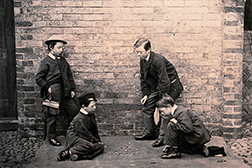The solutions to the problem of violence in children are not clear..
But we know that there is a problem when children start killing other children in their schools. It may seem that there is little that one individual can do to stem the larger social tides that underlie this problem. We can, however, take steps within our own homes to reduce the probability of raising children who succumb to violent behavior.
Research studies have shown that aggressive behavior is learned early in life. Parents, family members, and others can take steps to reduce or minimize violence by raising children in safe, loving and trusting homes. We all make mistakes in our lives, and this may seem especially true when it comes to raising children, but trying to do our best can have a great impact on the lives of children. Here are some specific steps we can take to minimize the chances that our kids will grow up to be violent.
 Give Children Plenty of Love and Attention Give Children Plenty of Love and Attention
Behavior problems and delinquency are less likely to develop when children, especially at an early age, have a parent or other adult who is involved in their lives. Every child needs a consistent, strong, and loving relationship with an adult to develop a sense of trust and feel safe. Without this bond, a child may grow up to become difficult to manage, hostile, and distrustful. It is often a challenge to show love to a child on a consistent basis. If you feel unable to do this, it is helpful to seek the guidance of a therapist who can lead you to uncover the reasons for this difficulty, as well as encourage you in a safe and supportive therapy setting to learn new responses that can alleviate difficulties for both you and the child. Children have minds of their own – as they grow and become more independent, they may behave in ways which anger and frustrate you. You need patience and a commitment to see things through their eyes in order to deal with your own feelings. Try not to respond to your child with hostile words and actions – this approach only serves to teach the child that aggressive behavior is the way to deal with emotions.
Don’t Use Physical Punishment
With Children
Hitting children stops an unwanted behavior for only a short time – and the more it is done, the child may adapt so that it has little effect in changing behavior. The long-term effects on the child may be devastating and increase the likelihood of violence in the future. Spanking, slapping, and hitting show children that aggression is a way to deal with problems. Adopt instead the idea that the child will make mistakes but that he or she can learn how to correct them. Take the positive approach – don’t humiliate or embarrass children. Show them what they did wrong and point out, in a loving and respectful way, how to avoid making similar mistakes in the future. Children need this kind of guidance.
There are nonphysical forms of discipline which, when applied consistently and reasonably, can teach children nonviolent ways to deal with problems – primarily in the form of consequences. For example, giving the child a “time out,” where the child has to sit quietly alone for a reasonable amount of time (five to fifteen minutes), is an effective alternative. Or certain treats or privileges can be withdrawn. Similarly, with older children, “grounding,” where they are not allowed to spend time with friends or participate in some activities, can be an effective form of discipline. When discipline is applied, be consistent and try to involve your child in setting up rules. Explain clearly what you expect and let them understand the consequences if they break a rule. Above all, when you make a rule, stick to it because children need clear expectations and structure. Not enforcing a rule is confusing and only teaches children to see how far they can test limits. Some parents feel the need to be a friend to their child, and there is a place for this; however, the child probably has many friends, but few adults who can teach them adaptive ways of living as they grow up. They need the guidance of the adult.
Show Children Appropriate Ways of Behaving Through Your Example
The behavior, beliefs, values and attitudes of parents, siblings and other adults have a powerful influence on a child. The child who has a firm sense of what it is to be honest, respectful, trustworthy, and responsible will have a good start in enjoying a healthy emotional life as an adult. These values also help children in withstanding negative peer pressure in school. Children learn these values within the households they grow up in. Take a firm approach when a child acts aggressively toward others. Children can learn non-aggressive ways to handle problems. You can help them do this by discussing the problems with them, asking them to consider the consequences when they use violence to solve the problem, and talking about ways to solve the problem without violence. Teach them that problems can be solved with calm words rather than threats, fists or weapons. Teach children your hobbies or sports. Attentively help them develop their own talents in what they do best and have an interest in. Read stories to younger children and take older children to a bookstore or library.
Supervise Your Children
Research has shown that unsupervised children often have behavior problems. Children need the guidance of an adult – they need protection, encouragement, support, and a feeling of safety as they grow up. They need to learn to think and act for themselves in healthy and effective ways. You should make ground-rules at home – you need to know where your children are at all times, and you need to know who their friends are. Never leave very young children alone, even briefly. As the children grow older, get someone to watch them if you are not able to do it yourself. Encourage your school-aged and adolescent children to enroll in community programs and after-school activities such as sports teams or organized recreational activities. Accompany children to their organized play activities and observe how they get along with other children. Teach them how to respond appropriately, and non-violently, to other children who hit, insult, or threaten their playmates. Explain that they should avoid these children and show them that these are not appropriate behaviors.
 If you own or use firearms, you need to teach your children about the danger of weapons. Never store guns where your children can find them. If there is a gun in the home, it should be locked and unloaded. The bullets should be kept in a separate location. Never carry a gun in the presence of a child – this will only teach them the wrong message that guns are OK and that they can be used to solve problems. If you own or use firearms, you need to teach your children about the danger of weapons. Never store guns where your children can find them. If there is a gun in the home, it should be locked and unloaded. The bullets should be kept in a separate location. Never carry a gun in the presence of a child – this will only teach them the wrong message that guns are OK and that they can be used to solve problems.
Decrease Exposure to Violence
Children need to grow up in safety and with love. A violent home can be frightening and damaging to children. Aggression between adults, especially those involving angry blowups, can terrify children and teach them destructive ways to handle conflict. Try to discourage aggression between brothers and sisters in the home. If the people in your household engage in physical or emotional abuse toward each other, seek the help of a trained therapist who can help you explore the reasons that violence occurs and suggest healthier ways of dealing with conflicts. Anger is a normal emotion, but it needs to be expressed in a supportive, rational and problem-solving way. It does not have to be linked to violence or aggression.
Kids are exposed to a great deal of violence in the media, and research has shown that this can lead them to behave aggressively. You can control the amount of violence your children witness. For example, you might allow them to watch carefully selected TV shows or play video games for only an hour or two per day. You should know what video games they play and what movies they watch. Talk to them about violence, help them see the consequences for engaging in violent behavior, and discuss ways of solving problems without violence.
Take Steps to Protect Children
From Violence
Children need to be taught that they can stand up to violence. They can learn that it takes more courage to resist violence than to succumb to it. They should learn that name-calling, bullying, and threats can set the scene for violent outcomes, but that they can stand up to this in a firm and calm way if it happens to them.
 Children can be protected against becoming the victims of violence. For example, they can be taught to use safe, well-lit, and busy routes for walking in the neighborhood and to walk always with a friend. If they see any suspicious activity, they should know how to report it to their parents, another adult, or the police. They should know the dangers of talking to strangers or going somewhere with anyone they don’t know and trust. And they should be taught that if anyone tries to hurt them, they should say “no,” run away from the scene and tell a responsible adult – as if their lives depended on it. Children can be protected against becoming the victims of violence. For example, they can be taught to use safe, well-lit, and busy routes for walking in the neighborhood and to walk always with a friend. If they see any suspicious activity, they should know how to report it to their parents, another adult, or the police. They should know the dangers of talking to strangers or going somewhere with anyone they don’t know and trust. And they should be taught that if anyone tries to hurt them, they should say “no,” run away from the scene and tell a responsible adult – as if their lives depended on it.
Although we do not have control over all the causes of violence in children, we can at least take steps to help our kids grow up with a sense of love and safety, as well as the skills to know how to resist violence in their lives. The rewards of effective parenting are enormous. If your household is characterized by violence, or if your child seems prone to excessive anger or violent behavior, realize that there is effective help through therapy. Our children are our legacy and the future.
They deserve love and the wisdom that we can pass on to them. |

